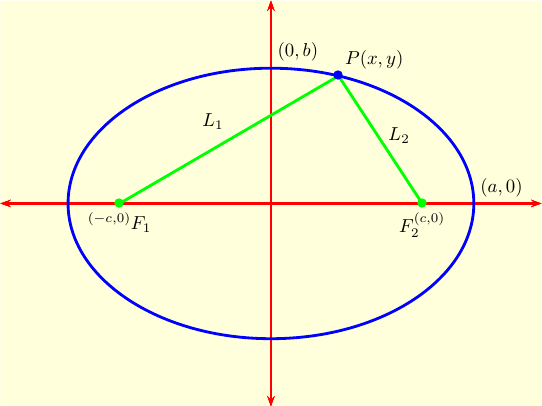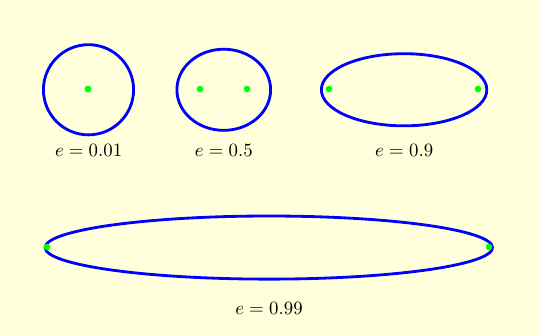Ellipses can be elegantly
described in four ways.
- Via Cartesian (rectangular) coordinates.
- In terms of distances to two foci (plural of focus).
- In terms of distances to a focus and a directrix.
- In polar coordinates.
|
We will do the first two on this
page, and the third and fourth later on.
The simplest description of an
ellipse is as a squashed or stretched circle. Start with the unit
circle $x^2 + y^2 =1$, and stretch it by a factor of $a$ in the $x$
direction and $b$ in the $y$ direction to get:
|
The standard formula for an ellipse in rectangular coordinates is
$$\frac{x^2}{a^2} + \frac{y^2}{b^2} = 1.$$
|
The points $(\pm a,0)$ (and
sometimes the points $(0,\pm b)$) are called vertices. If
$a > b > 0$, then the major axis is the line segment from
$(-a,0)$ to $(a,0)$ and the semi-major axis is the line segment
from the origin to $(a,0)$. Likewise, the minor axis runs from
$(0,-b)$ to $(0,b)$ and the semi-minor axis runs from the
origin to $(0,b)$. If $b > a > 0$, then the major and semi-major
axes are vertical and the minor and semi-minor axes are
horizontal. For now we'll stick with the case that $a > b$, so that the
ellipse is short and fat. The origin is the center of the
ellipse.
|
Now let $c = \sqrt{a^2-b^2}$. The points $(\pm c, 0)$ are
called foci. These points are extremely important in astronomy,
since planets follow elliptical orbits with the sun at a
focus, not with the
sun at the center.
Let $F_1(-c,0)$ and $F_2(c,0)$ be the two foci, let $P(x,y)$ be an
arbitrary point on the ellipse. Let $L_1$ be the distance from $F_1$
to $P$, and let $L_2$ be the distance from $F_2$ to $P$, as
in the figure on the right.
|

|
|
Amazing fact: The ellipse is the set of all points where
$L_1 + L_2 = 2a$.
|
This fact gives elliptical rooms
amazing acoustic properties. If you whisper at one focus of such a
room, the sound waves from your voice will bounce off the walls and
converge at the other focus -- that's why it is called a focus. The
same goes for light reflecting off elliptical mirrors.
To understand the amazing fact,
let's convert the equation $L_1 + L_2 = 2a$ to rectangular
coordinates:
\begin{eqnarray*} L_1 + L_2 & = & 2a \cr\cr
L_1 & = & 2a-L_2 \cr \cr
\sqrt{(x+c)^2+y^2} & = & 2a -\sqrt{(x-c)^2 + y^2} \cr\cr
(x+c)^2 + y^2 & = & 4a^2 + (x-c)^2 + y^2 - 4a \sqrt{(x-c)^2 + y^2}\cr\cr
4a\sqrt{(x-c)^2 + y^2}&=& 4a^2-4cx \cr \cr
a \sqrt{(x-c)^2 + y^2} &=& a^2-cx \cr \cr
a^2(x-c)^2+ a^2 y^2 &=& a^4+c^2x^2 -2a^2cx \cr \cr
a^2x^2 + a^2c^2 -2a^2cx + y^2 &=& a^4 + c^2x^2 -2a^2cx \cr \cr
(a^2-c^2)x^2 + a^2 y^2 &=& a^2(a^2-c^2) \cr \cr
b^2 x^2 + a^2 y^2 &=& a^2b^2 \cr \cr
\frac{x^2}{a^2} + \frac{y^2}{b^2} &=& 1,\end{eqnarray*}
where we have used the fact that $b^2=a^2-c^2$. That's a long and
messy calculation for a simple and elegant result.
You should be able to construct
the equation of an ellipse given any two of $a$, $b$ and $c$, since
you can get the third from $c^2=a^2-b^2.$
Example 1: Find the location of the foci of the ellipse
$\displaystyle{\frac{x^2}{25} + \frac{y^2}{9}=1}$.
|
Solution:
We have $a=5$ and $b=3$, so $c = \sqrt{a^2-b^2} = 4$. The foci are at
$(\pm 4,0)$.
|
Example 2: Find the equation of an ellipse
with foci at $(\pm 3,0)$ if $b=4$.
|
Solution:
Since $c=3$ and $b=4$, $a^2=3^2+4^2=25$, so $a=5$. This makes the equation
$$\frac{x^2}{25} + \frac{y^2}{16} = 1.$$
|
|
The ratio $c/a$ is called
the eccentricity of the ellipse, and is usually denoted
$e$. Note that $e < 1$. A circle can be viewed as an ellipse with
eccentricity zero, and with both foci at the origin.
|

|
|
It is easy to plot an ellipse as a parametrized curve. Just take
$$x = a \cos(t); \qquad y = b\sin(t),$$
with the parameter $t$ running from $0$ to $2\pi$.
|

